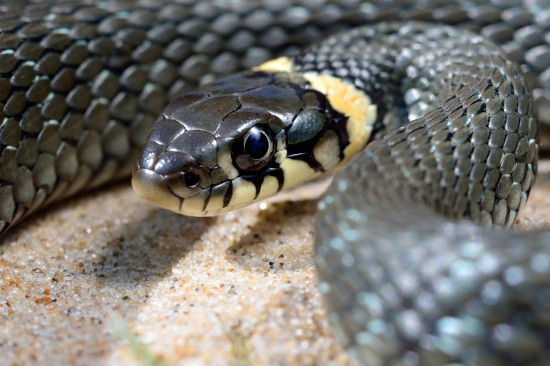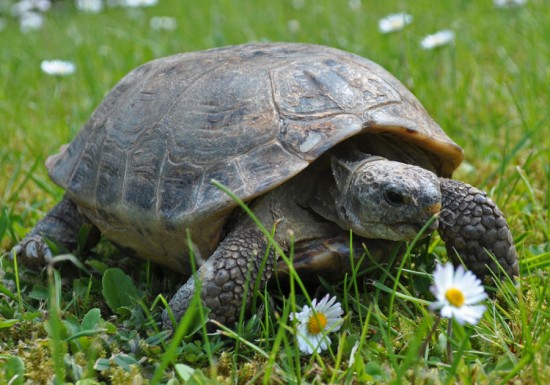

As reptiles rather than mammals, snakes are just about as different from people as it is possible to be! Snakes of course rely on the use of their senses to navigate and find out what is around them, the same as any other animal, but the structures of their various sense organs are very different to those that we are familiar with. In this article, we will examine the senses of the snake, how they work, and how effective they are. Read on to learn more!
Snakes are even unique from other reptiles such as lizards in terms of their hearing and the structure of their ears, as it is not hugely important to them to be able to hear airborne sounds, due to their living largely underground. Snakes can fairly be considered as virtually deaf, as they lack the middle ear and eardrum structures that even most other reptiles possess to enable hearing.
This does not mean that the snake’s ears do not serve any purpose, however! The inner ear structure of the snake is important to help them to maintain their balance and orientation, and literally tell which way is up! The snake is also very sensitive to ground vibrations, such as the approach of another animal, or moving traffic. The vibrations of movement through the ground are transmitted to the inner ear of the snake via the bones of their skulls, allowing them to detect an approach or something moving near to them.
As burrowing animals that have evolved into creatures that spend the larger parts of their days underground, sight is one of their little-utilised and poorer senses. Again, their eyesight cannot even be compared to other reptiles such as lizards, and the eyes of the snake are significantly different.
Snakes do not have eyelids, but instead have a transparent scale over the eye to protect the eyes, which also provides them with their steely, unblinking stare. The lens of the snake’s eye is yellow in colour, and focuses telescopically by moving back and forth, rather than by opening and closing the pupil. This causes snakes to be relatively short-sighted, and not capable of any great degree of distance vision. The retina of the eye of the snake also possesses a unique light-sensitive double cone, to help them to judge the time of day.
While snakes are somewhat renowned for their stare and apparent eye contact, in truth, snakes cannot see very well at all, and are much better at detecting things visually when they move than when they are still.
The snake possesses an organ within the roof of their mouths, known as “Jacobson’s Organ,” which provides them with both a taste and scent-oriented means of tasting their food. This organ is also useful in gathering information about their surroundings, and can best be described simply as a dual scent and taste organ within the mouth.
Jacobson’s Organ is constructed of two side-by-side cavities in the roof of the mouth, that gather scents and stimulus onto them by means of the snake’s flickering tongue, which does not have any taste buds or sense of taste in and of itself. The organ collects minute scent particles from in the air, allowing the snake to “taste” their environment, find a mate, avoid predators, and seek out prey!
The nose of the snake itself is also comparatively large, and the snake’s nasal sense of smell is also very keen.
The snake’s sense of touch is relatively keen too, and their bodies have pressure receptors on the skin, which give feedback about their terrain and environment. Their skin is sensitive to the touch, and even a light touch can be felt clearly by the snake. They also have temperature receptors within the skin, allowing them to judge the ambient temperature, find a warm spot, and hole up and brumate when the weather gets cooler.
The snake also has a range of other senses that we as humans do not possess, some of which vary from species to species.
Some vipers and rattlesnakes have infra-red sensors, which allow them to detect the body heat of potential prey and home in on it, and also give them a superior ability to hunt for small prey in total darkness.
A lot of the snake species from the Coloubrid grouping also have unique organs around the vents of their bottom jaws, which help them to identify and select a mate.
As with all other animals, snakes and their senses are a result of the species’ evolution, and as one of the most ancient of species, snakes are really well equipped to navigate their native environments. A lack of good hearing and eyesight poses no problem to snakes, as they have instead evolved other traits, such as their smell and taste, to allow them to work well within the environments in which they live, find suitable prey, and stay safe.
 The best thing that needs to be learnt about pets
The best thing that needs to be learnt about pets
The best thing that needs to be learnt about pets
The best thing that needs to be learnt about pets
 Horses - Which Breed Is Best For Me?
Horses - Which Br
Horses - Which Breed Is Best For Me?
Horses - Which Br
 8 Good Reasons Why Adding Olive Oil To A Dogs Diet Works
8 Good Reasons Wh
8 Good Reasons Why Adding Olive Oil To A Dogs Diet Works
8 Good Reasons Wh
 Lifetime Costs Of Dog Ownership
Lifetime Costs Of
Lifetime Costs Of Dog Ownership
Lifetime Costs Of
 Pet Insurance For Exotic Pets
Pet Insurance For
Pet Insurance For Exotic Pets
Pet Insurance For
Copyright © 2005-2016 Pet Information All Rights Reserved
Contact us: www162date@outlook.com